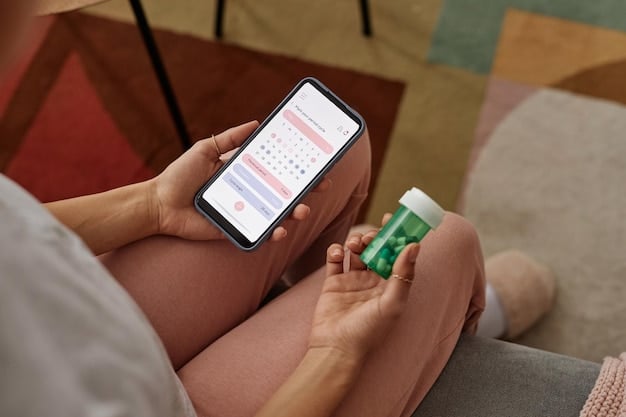Don’t Miss Your Free Annual Wellness Visit Before Year-End

Navigating healthcare can be complex, but understanding your eligibility for a free annual wellness visit is a crucial step for proactive health management, especially as the year draws to a close.
As the year-end approaches, a critical opportunity often overlooked by many Americans is the Time-Sensitive: Get Your Free Annual Wellness Visit Before the End of the Year. This isn’t merely a routine check-up; it’s a strategically designed benefit intended to empower you in taking a proactive stance on your health.
Understanding the Annual Wellness Visit: More Than Just a Check-Up
Many individuals confuse the annual wellness visit (AWV) with a traditional physical exam. While both focus on health, they serve distinct purposes, particularly under Medicare. The AWV is not about hands-on physical assessments or blood tests in the same way a physical is. Instead, it’s a strategic planning session for your health.
This visit is designed to help you and your doctor develop a personalized prevention plan. It focuses on identifying potential health risks and creating strategies to mitigate them, ultimately aiming to keep you healthier and potentially reduce future medical costs. It’s a forward-looking approach to health management, emphasizing prevention over treatment.
What Differentiates an AWV from a Physical?
The core difference lies in their primary objectives and what they entail. A physical exam typically involves a head-to-toe assessment, including palpation, listening to heart and lungs, and often blood work to check for existing conditions. It’s diagnostic in nature.
- Annual Wellness Visit (AWV): Focuses on preventive care planning. It includes a health risk assessment, review of medical and family history, creation of a personalized prevention plan, and discussion of screeninings and services tailored to your needs.
- Traditional Physical Exam: Involves a physical examination of the body, often including blood tests, urine tests, and other diagnostic procedures to detect and diagnose medical conditions.
Understanding this distinction is vital to ensure you utilize your benefits effectively. The AWV is about planning for the future, while a physical is about assessing your current state of health and addressing any immediate concerns or symptoms.
One common misconception is that you need to be sick to benefit from an AWV. Quite the opposite is true. This visit is for those who are well, or relatively well, and want to stay that way. It’s foundational for long-term health, helping to identify and address risk factors before they escalate into serious health issues. This proactive approach underscores the value of scheduling your visit.
Annual wellness visits typically involve a discussion about your medical and family history, current health conditions, and a review of your lifestyle. This holistic approach allows healthcare providers to get a comprehensive picture of your health status and work with you to develop a tailored preventive care plan. The goal is to set you on a path to sustained well-being, rather than reacting to illness after it strikes. This preventative focus is what makes the AWV a unique and invaluable tool in managing your health.
The AWV also serves as an opportunity to discuss any chronic conditions you might have and how they are being managed. Your doctor might suggest specific lifestyle changes, refer you to specialists, or recommend vaccinations that are appropriate for your age and health status. The discussion often covers mental health screenings, cognitive assessments, and a review of your medication list to ensure there are no adverse interactions or unnecessary prescriptions. This thorough review helps ensure all aspects of your health are considered and addressed, reinforcing the comprehensive nature of the visit.
Eligibility and Coverage: Who Qualifies for a Free Visit?
The annual wellness visit is typically covered by Medicare Part B, but specific eligibility requirements must be met. It’s essential to understand these criteria to ensure you can take advantage of this no-cost benefit. Generally, if you have Medicare Part B, you qualify, but there are certain timeframes to consider and conditions that apply.
The primary qualification is that you must have been enrolled in Medicare Part B for at least 12 months. Additionally, you cannot have had another annual wellness visit within the past 12 months. This ensures fairness and prevents overuse of the benefit, while still allowing for regular preventive health planning.
Medicare’s Criteria for AWV Coverage
- Enrollment Period: You must have been enrolled in Medicare Part B for more than 12 months. This period ensures that you are an established Medicare beneficiary before accessing the AWV.
- Prior Visits: You cannot have had an Initial Preventive Physical Exam (IPPE), also known as the “Welcome to Medicare” visit, or an AWV within the last 12 months. This rule helps maintain the annual rhythm of these preventive visits.
It’s important to note that while the AWV itself is free, certain additional services performed during the same visit might incur costs. For instance, if your doctor addresses a new health concern or performs tests not considered part of the preventive planning, you might be responsible for a co-pay or deductible. It’s always best to clarify with your provider or Medicare prior to your appointment what is covered to avoid unexpected bills.
Navigating healthcare benefits can be tricky, but understanding the specifics of your coverage for the annual wellness visit can save you money and ensure you receive the care you need. Don’t assume anything; always verify with your insurance provider or the healthcare facility’s billing department before your appointment. This proactive approach to understanding your benefits extends to more than just the annual wellness visit. For example, some plans might offer additional coverage for specific tests or screenings that are not standard under the AWV. It’s also wise to inquire about any potential co-payments or deductibles for diagnostic services that might be ordered during the visit, as these are typically separate from the wellness visit itself. Being fully informed about your plan’s details can prevent financial surprises and help you maximize your healthcare dollar.
Beyond just understanding the financial aspects, knowing the specifics of your AWV coverage also includes understanding what services are explicitly part of the visit. Some providers might offer additional services during the same appointment that are not covered under the AWV, even if they are beneficial to your overall health. For example, flu shots or other immunizations might be offered but are billed separately. Similarly, if a problem is identified during the AWV that requires immediate medical attention, this follow-up consultation or diagnostic work may be billed as a separate office visit. Always ask your provider to clearly differentiate between services covered by the AWV and those that may incur an extra charge to ensure transparency and avoid any unexpected bills. Clear communication is key to navigating these aspects effectively.
Key Components of Your Annual Wellness Visit

The annual wellness visit is structured to gather comprehensive information about your health and create a proactive plan. It’s not a quick in-and-out appointment; rather, it’s an opportunity for a meaningful dialogue with your healthcare provider about your overall well-being. Understanding its core components can help you prepare and maximize its benefits.
The focus is strongly on preventive measures, risk assessment, and personalized health planning. This includes evaluating your current health status, identifying potential risks, and developing strategies to maintain your health for the year ahead. Preparing for this visit can make it even more productive.
What to Expect During Your AWV
While the exact flow may vary slightly, an annual wellness visit typically includes several key elements aimed at providing a holistic view of your health and future needs.
- Health Risk Assessment: You’ll complete a questionnaire about your health status, lifestyle, and potential risk factors. This helps your provider tailor the visit to your individual needs.
- Medical and Family History Review: A thorough discussion of your past medical conditions, surgeries, medications, and family health history helps identify hereditary risks and track your medical journey.
- Personalized Prevention Plan: Based on the assessment, your doctor will develop a plan. This might include recommended screenings, health education, lifestyle modifications, or referrals to specialists.
- Cognitive Assessment: A brief evaluation to assess cognitive function and detect any signs of dementia or Alzheimer’s disease.
- Discussion of Advance Directives: An opportunity to discuss your preferences for medical care in the future, if you choose to do so.
The AWV is an ideal time to ask questions about your health, discuss any concerns you might have, and actively participate in planning your health trajectory. It’s a collaborative effort between you and your healthcare provider, aimed at promoting long-term health and preventing illness. This consultative approach is a hallmark of the annual wellness visit, distinguishing it from reactive care.
Your active participation in the AWV is key to its success. Coming prepared with a list of medications, supplements, and any specific health concerns or questions can significantly enhance the value of the visit. Don’t hesitate to voice any worries about your health or clarification about preventive screenings. The more comprehensive the information you provide, the better equipped your healthcare provider will be to develop a truly personalized and effective prevention plan. This visit is your chance to be proactive about your health, ensuring that your care aligns with your goals and addressing any gaps in your current health strategy. It’s an investment in your future well-being.
The Benefits of Regular Annual Wellness Visits
Beyond simply fulfilling a Medicare requirement, the annual wellness visit offers a plethora of benefits that extend far beyond a single appointment. These visits play a crucial role in preventative care, early detection, and ultimately, a better quality of life for seniors. By consistently engaging with this benefit, individuals can achieve a more comprehensive and proactive approach to their health management.
The value of an AWV lies in its forward-looking nature. It shifts the focus from treating illness to preventing it, helping to identify potential issues before they become serious problems. This proactive strategy is fundamental to maintaining well-being as we age.
Long-Term Health Advantages
Regular annual wellness visits accumulate benefits over time, creating a robust foundation for sustained health and minimizing future healthcare burdens.
- Early Detection: By consistently assessing risk factors and reviewing health history, AWVs can help identify potential health issues early, when they are often easier and less costly to treat.
- Personalized Care Plan: Each visit refines your personalized prevention plan, adapting it to your evolving health needs and ensuring you receive the most relevant screenings and advice.
- Improved Health Outcomes: Proactive management of chronic conditions and adherence to preventive guidelines lead to better overall health outcomes and reduced likelihood of acute health crises.
- Empowerment Through Education: These visits provide an excellent opportunity to learn more about your health and how to make informed decisions for your well-being, fostering a sense of control and empowerment.
Ultimately, making the annual wellness visit a regular part of your healthcare routine is an investment in your future health. It’s a strategic opportunity to partner with your healthcare provider in preventing disease, managing chronic conditions, and ensuring a higher quality of life for years to come. This commitment to ongoing prevention can significantly impact your longevity and overall health trajectory.
The consistency of annual wellness visits also fosters a stronger doctor-patient relationship. Regular interaction allows your healthcare provider to gain a deeper understanding of your lifestyle, preferences, and challenges, leading to more empathetic and effective care. This ongoing dialogue permits continuous assessment and adjustment of your health plan, ensuring it remains relevant and effective as circumstances change. Furthermore, these visits reinforce the importance of preventive health behaviors, providing regular reminders and motivation to adhere to healthy habits. The cumulative effect of these visits is a truly personalized healthcare experience that prioritizes your long-term health and well-being. It moves healthcare from a reactive model to a truly proactive, partnership-based approach.
Common Misconceptions and How to Address Them
Despite the clear benefits of the annual wellness visit, several misconceptions persist that can deter individuals from scheduling their appointments. Addressing these misunderstandings is crucial to ensuring more people take advantage of this valuable, free healthcare service. Many people assume they don’t need it because they feel perfectly healthy, or they confuse it with other types of medical appointments.
One prevalent misconception is that an AWV is just another physical. As discussed, it focuses on future health planning rather than a physical examination. Dispelling this myth is key to encouraging participation. Another common misunderstanding is that it only applies to those with severe health issues.
Debunking Myths Around the AWV
Here are some of the most common misunderstandings and how best to clarify them, empowering you to make informed decisions about your health care.
- “It’s just another physical.” Clarification: The AWV is a planning session for preventive care, focusing on risk assessment and health education, not a hands-on physical exam.
- “I don’t need it because I feel healthy.” Clarification: AWVs are for *preventing* illness. Even if you feel well, identifying potential risks early is crucial to staying healthy.
- “It will cost me money.” Clarification: For eligible Medicare Part B beneficiaries, the AWV is 100% free with no co-pay or deductible. However, additional services on the same day might incur costs.
- “It’s too much hassle/takes too long.” Clarification: The visit is streamlined for efficiency, focusing on essential preventive planning. The long-term health benefits far outweigh the time commitment.
It’s important to openly communicate with your healthcare provider about what an AWV entails and what is covered under your plan. Don’t hesitate to ask questions to ensure you fully understand the process and its benefits. By addressing these misconceptions proactively, more individuals can leverage this fundamental benefit for proactive health management, fostering a healthier community overall.
Another common concern is related to what information is shared during the AWV. Some individuals might be hesitant to share personal details about their lifestyle, fearing judgment or privacy breaches. However, healthcare providers are bound by strict confidentiality rules (HIPAA), ensuring that all information disclosed during the visit remains private and is used solely for the purpose of your health planning. It’s critical to foster an environment of trust, as open and honest communication about your lifestyle habits, medical history, and mental well-being is vital for developing the most effective and personalized prevention plan. Recognizing the privacy safeguards in place can help alleviate these concerns and encourage a more transparent dialogue, ultimately enhancing the quality of your preventive care. The visit is designed to be a safe space for discussing all aspects of your health without reservation.
Navigating the Process: Scheduling Your Visit
Scheduling your annual wellness visit doesn’t have to be complicated, but understanding the steps can streamline the process. The end of the year often brings a rush for appointments, so planning ahead is often the best strategy to ensure you secure a spot with your preferred provider. This is especially true for the Time-Sensitive: Get Your Free Annual Wellness Visit Before the End of the Year, as many try to use their benefits before they expire or reset.
Many healthcare providers now offer online scheduling or dedicated phone lines specific to wellness visits. Leveraging these resources can make the process more efficient. Being prepared with your Medicare information and any health history updates can also speed up the on-site part of your visit.
Step-by-Step Guide to Scheduling
Follow these steps to successfully schedule and prepare for your free annual wellness visit, ensuring you optimize this important health benefit.

- Verify Eligibility: First, ensure you meet Medicare’s criteria for the AWV (enrolled in Part B for 12+ months, no AWV/IPPE in the last 12 months).
- Contact Your Provider: Reach out to your primary care physician’s office. Clearly state you want to schedule your “Medicare Annual Wellness Visit.”
- Specify Benefits: Confirm with the scheduler that the visit is billed as an “Annual Wellness Visit” to ensure it’s covered at no cost. Inquire if any additional services (e.g., blood tests for specific conditions) might be recommended and if they would involve separate charges.
- Prepare for Your Visit: Gather any questions you have, a list of current medications and supplements, and any recent changes in your health or family history.
Remember, the end of the year can be a busy period for healthcare practices. Don’t wait until the last minute to schedule, as appointment availability may become limited. Proactive scheduling ensures you don’t miss out on this crucial, free opportunity to maintain your health. This diligence reflects an empowered approach to your healthcare journey.
Some clinics also offer telehealth options for the annual wellness visit, which can be a convenient alternative if you have limited mobility or transportation. Inquire if your provider offers virtual AWVs and what technological requirements are necessary (e.g., a reliable internet connection, a device with a camera and microphone). While a virtual visit cannot replace all aspects of an in-person examination, it can still cover the essential elements of the health risk assessment, medical history review, and personalized prevention planning. This flexibility can make it easier for more people to access their annual wellness benefit, especially those in rural areas or with busy schedules. Always confirm with your provider if a virtual AWV is appropriate for your specific health needs and what to expect during the remote session.
Ensuring a Smooth and Productive Visit
A productive annual wellness visit isn’t just about showing up; it’s about active participation and preparation. To make the most of this free benefit, take steps beforehand to gather necessary information and think about what you want to discuss with your healthcare provider. This proactive approach ensures that your time with the doctor is as effective and tailored to your individual needs as possible.
The goal is to facilitate a comprehensive discussion about your health risks and preventive strategies. Coming prepared helps your doctor understand your full health picture and allows them to provide the most relevant advice and recommendations.
Tips for Optimizing Your AWV
To maximize the value of your annual wellness visit, consider these practical tips that will facilitate a more thorough and personalized discussion with your doctor.
- Bring a List of Medications: Include all prescription drugs, over-the-counter medications, vitamins, and herbal supplements. Note dosages and how often you take them.
- Prepare Your Health Questions: Write down any health concerns, new symptoms, or questions you have about your health or recommended screenings. This ensures you don’t forget important points during the visit.
- Update Medical History: Be prepared to discuss any new diagnoses, hospitalizations, surgeries, or significant family health history changes since your last visit.
- Discuss Lifestyle Habits: Be open about your diet, exercise routine, smoking, alcohol consumption, and stress levels. This information is crucial for personalized advice.
- Ask About Screenings: Inquire about recommended preventive screenings based on your age, gender, and risk factors (e.g., mammograms, colonoscopies, bone density tests).
By taking these steps, you contribute significantly to the depth and effectiveness of your annual wellness visit. It transforms the appointment from a mere formality into a truly collaborative partnership for your long-term health. An engaged patient is often a healthier patient, and the AWV is a prime opportunity to embody that philosophy. This preparation not only benefits you directly but also assists your healthcare provider in delivering the highest quality of preventive care tailored precisely to your unique health profile, creating a truly symbiotic relationship focused on sustained well-being.
| Key Point | Brief Description |
|---|---|
| 🗓️ Time-Sensitive | Schedule your free annual wellness visit before the year ends to utilize your full benefit. |
| ✔️ Free Benefit | Medicare Part B covers the annual wellness visit at no cost if eligibility requirements are met. |
| 🩹 Prevention Focus | The AWV is about proactive health planning and risk assessment, not a traditional physical. |
| ✅ Eligibility Check | Ensure you’ve had Medicare Part B for 12+ months and no prior AWV in the last year. |
Frequently Asked Questions About the Annual Wellness Visit
An AWV is a preventive care planning session covered by Medicare, focusing on creating a personalized health plan, identifying health risks, and providing health education. It differs from a regular physical, which is a hands-on physical examination to diagnose new or existing conditions. The AWV typically doesn’t involve physical exams or blood tests.
You are generally eligible if you have Medicare Part B for at least 12 months and have not had an Annual Wellness Visit or an Initial Preventive Physical Exam (IPPE, “Welcome to Medicare” visit) within the last 12 months. This benefit aims to encourage ongoing preventive care.
To ensure a productive AWV, bring a comprehensive list of all your medications (prescription and over-the-counter), supplements, and any questions or concerns about your health. It’s also helpful to have your updated medical and family health history ready for discussion with your provider.
The AWV itself is free under Medicare Part B, meaning no co-pay or deductible. However, if your doctor performs additional tests or addresses new symptoms during the same visit that are not part of preventive planning, you may incur separate charges. Always clarify what is covered beforehand.
The AWV benefit is typically renewed annually. Scheduling it before year-end ensures you utilize your current year’s benefit and stay on track with your preventive health planning without missing an opportunity for this valuable, free service that supports your long-term well-being.
Seize the Opportunity for Proactive Health
The free annual wellness visit is more than just a benefit; it’s a strategic tool for maintaining and enhancing your health. As the year draws to a close, the urgency to schedule this important appointment becomes clear. It’s an opportunity to engage proactively with your healthcare provider, understand your health risks, and collaboratively build a personalized plan for your well-being. Don’t let this valuable, no-cost service slip away. Prioritize your health today by securing your annual wellness visit before the year ends, investing in a healthier, more vibrant tomorrow.





